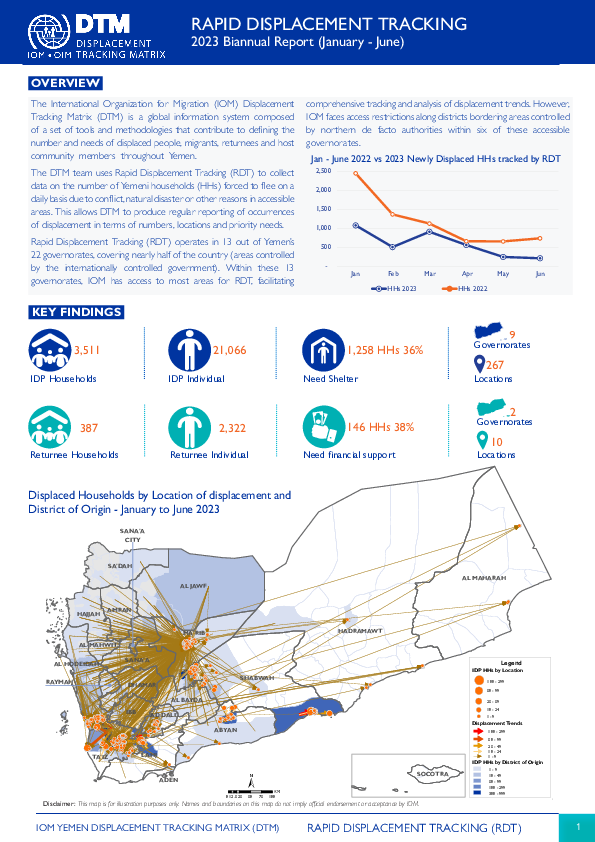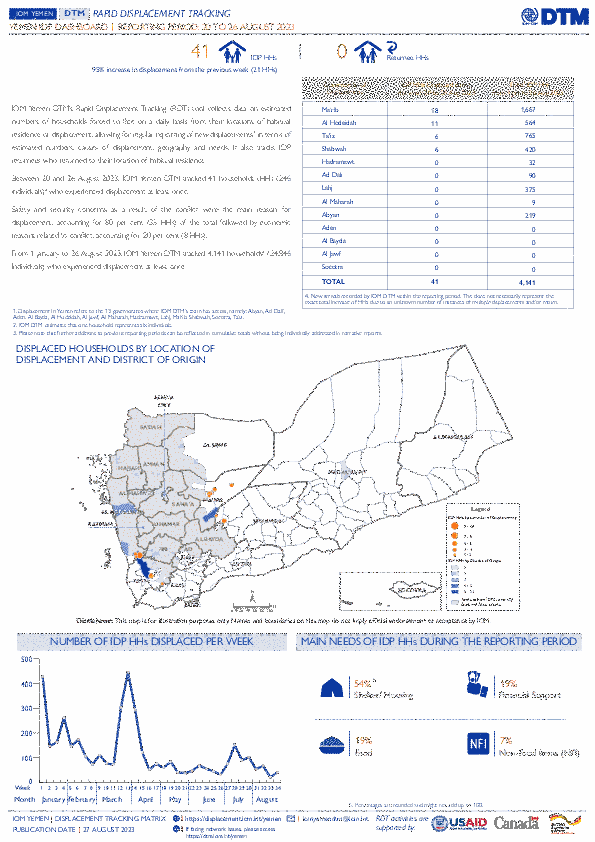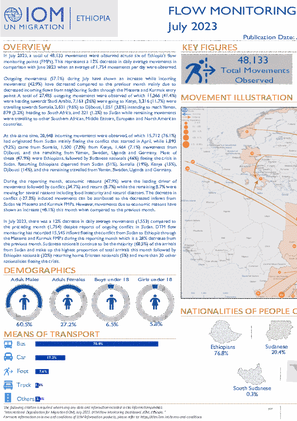-
Countries
-
Data and Analysis
-
Special Focus
-
Crisis Responses

Contact
DTM Europe, DTMMediterranean@iom.int
Language
English
Location
Bosnia & Herzegovina
Period Covered
Jul 19 2023
Jul 25 2023
Activity
- Flow Monitoring
This report provides insights into the profiles, experiences, needs, routes travelled and intentions of migrants transiting through Bosnia and Herzegovina (BiH).
IOM carried out a route observation exercise in the Republika Srpska, Sarajevo Canton and Una Sana Canton from 19 to 25 July to monitor trends in entries and exits as well as transit modalities within BiH. During this exercise, IOM also surveyed 289 migrants in active transit locations such as bus stops or at key entry and exit locations throughout the country.
Contact
DTM Burundi, DTMBurundi@iom.int
Location
Burundi
Activity
- Mobility Tracking
- Site Assessment
Period Covered
Oct 05 2022 -Oct 19 2022
As of October 2022, the main cause of displacement was natural disasters (89%). Most IDPs (46%) were hosted in the provinces of Rumonge (19%), Cibitoke (14%), and Cankuzo (13%). Even though natural disasters were the main displacement reason, a considerable share of IDPs in the provinces of Mwaro (56%), Ruyigi (36%), Bujumbura Mairie (28%), Gitega (27%) and Muyinga (27%) were displaced due to other reasons.
Population Groups
Survey Methodology
Unit of Analysis Or Observation
Type of Survey or Assessment
Keywords
Geographical Scope
Administrative boundaries with available data
The current dataset covers the following administrative boundaries

Contact
DTM Europe, DTMMediterranean@iom.int
Language
English
Location
Slovakia
Period Covered
Apr 01 2023
Jun 30 2023
Activity
- Survey
- Return Intention
Since 24 February 2022, refugees from Ukraine and Third Country Nationals (TCNs) have been fleeing to neighbouring countries as a result of the war. As of July 2023, up to six million refugees from Ukraine were recorded across Europe. At the same time, more than 20 million border crossings of Ukrainian and Third- Country refugees and migrants were reported from Ukraine into the neighbouring countries since February 2022.
IOM has deployed its Displacement Tracking Matrix (DTM) tools since mid-April 2022 to collect individual surveys in neighbouring countries with persons crossing into Ukraine, with the aim to improve the understanding of main profiles, displacement patterns, intentions and needs of those moving into Ukraine.
This report is based on surveys collected in Slovakia between 01 April and 30 June 2023.
Key Findings
- Top countries of stay abroad: Slovakia (72%), Czechia (5%), United Kingdom (2%), Ireland (2%), Austria (1%), Germany (1%) and Poland (1%) .
- Intended destination: 81% to the same oblast of origin, 18% to a different oblast in Ukraine: Zakarpatska (75%), Lvivska (7%), Kyiv city (6%).
- Intentions upon crossing back: 56% going for a short visit, 40% plan to stay in Ukraine.
- Transport to cross back to Ukraine: bus (74%), train (25%), car/minibus (1%).
- Top needs upon crossing back: health services (53%), financial support (22%), employment (15%), medicines (14%), general information (13%), language courses (11%). (more than one answer was possible).
- Groups travelling with children: 68% of groups travelled with children aged less than 18 years.
- Travel mode: 61% alone and 39% in group.
- Experiences of discrimination: 12% experienced discrimination throughout their journey.
Contact
DTM Burundi, DTMBurundi@iom.int
Location
Burundi
Activity
- Mobility Tracking
- Site Assessment
Period Covered
May 02 2023 -May 19 2023
DTM identified 76,987 Internally Displaced Persons (IDPs) in 17,819 displaced households in the 18 provinces of Burundi during the month of May 2023. Among those identified, 89 per cent were displaced due to environment-related disasters while 11 per cent were a result of other reasons. A little more than half (54%) of IDPs are children, 18 years old and under.
Population Groups
Survey Methodology
Unit of Analysis Or Observation
Type of Survey or Assessment
Keywords
Geographical Scope
Administrative boundaries with available data
The current dataset covers the following administrative boundaries

Contact
DTM Yemen, iomyemendtm@iom.int
Language
English
Location
Yemen
Period Covered
Jan 01 2023
Jun 30 2023
Activity
- Mobility Tracking
Yemen, a country already ravaged by years of conflict and instability, continues to face the harsh reality of displacement. The first half of 2023 has seen a decrease in the number of people displaced from their homes in Yemen. DTM Recorded more than 21,066 people were forced to flee their homes, seeking safety and shelter elsewhere in the first six months of the year. This is a half decrease from the same period in 2022 when there were 42,012 displacements.
According to recent data, the governorates most affected by this crisis are Ma’rib, Ta’iz, Al Hodeidah, Shabwah, and Lahj.
The governorate with the highest number of displacements in the first half of 2023 was Marib, with 1,455 households (HHs) displaced. This is followed by Taiz (572 HHs), Al Hodeida (416 HHs), Shabwah (409 HHs) and lahj (341 HHs). The governorates with the lowest number of displacements are Abyan, Ad Dali’, Hadramawt, and Al Mahara.
Contact
DTM Yemen, iomyemendtm@iom.int
Location
Yemen
Activity
- Mobility Tracking
- Event Tracking
Period Covered
Aug 20 2023 -Aug 26 2023
From 1 January to 26 August 2023, IOM Yemen DTM tracked 4,141 households (HH) (24,846 Individuals) who experienced displacement at least once.
Between 20 and 26 August 2023, IOM Yemen DTM tracked 41 households (246 individuals) displaced at least once. The majority of people moved into/within the following governorates and districts:
- Ma’rib (18 HHs) – Ma’rib (11 HHs), Ma’rib City (5 HHs), Harib (2 HHs) districts. Most displacements in the governorate originated from Ma’rib and Hajjah.
- Al Hodeidah (11 HHs) – Hays (11 HHs) district. Most displacements in the governorate originated from Ta’iz and Al Hodeidah.
- Ta’iz (6 HHs) – Jabal Habashi (5 HHs), Ash Shamayatayn (1 HH) districts. All displacements in the governorate were internal.
- Ta’iz (15 HHs) – Maqbanah (12 HHs), Al Mudhaffar (2 HHs), Al Mawasit (1 HH) districts.
- Al Hodeidah (11 HHs) – Hays (5 HHs), At Tuhayta (3 HHs), Bajil (3 HHs) districts.
- Ma’rib (6 HHs) – Harib (5 HHs), Raghwan (1 HH) districts.
Population Groups
Survey Methodology
Unit of Analysis Or Observation
Type of Survey or Assessment
Keywords
Geographical Scope
Administrative boundaries with available data
The current dataset covers the following administrative boundaries

Contact
DTM Yemen, iomyemendtm@iom.int
Language
English
Location
Yemen
Period Covered
Aug 20 2023
Aug 26 2023
Activity
- Mobility Tracking
Dear Yemen Humanitarian Data Partners,
IOM Yemen DTM’s Rapid Displacement Tracking (RDT) tool collects data on estimated numbers of households forced to flee on a daily basis from their locations of origin or displacement, allowing for regular reporting of new displacements in terms of estimated numbers, geography, and needs. It also tracks returnees who returned to their location of origin.
From 1 January to 26 August 2023, IOM Yemen DTM tracked 4,141 households (HH) (24,846 Individuals) who experienced displacement at least once.
Between 20 and 26 August 2023, IOM Yemen DTM tracked 41 households (246 individuals) displaced at least once. The majority of people moved into/within the following governorates and districts:
- Ma’rib (18 HHs) – Ma’rib (11 HHs), Ma’rib City (5 HHs), Harib (2 HHs) districts. Most displacements in the governorate originated from Ma’rib and Hajjah.
- Al Hodeidah (11 HHs) – Hays (11 HHs) district. Most displacements in the governorate originated from Ta’iz and Al Hodeidah.
- Ta’iz (6 HHs) – Jabal Habashi (5 HHs), Ash Shamayatayn (1 HH) districts. All displacements in the governorate were internal.
The majority of people moved from the following governorates and districts:
- Ta’iz (15 HHs) – Maqbanah (12 HHs), Al Mudhaffar (2 HHs), Al Mawasit (1 HH) districts.
- Al Hodeidah (11 HHs) – Hays (5 HHs), At Tuhayta (3 HHs), Bajil (3 HHs) districts.
- Ma’rib (6 HHs) – Harib (5 HHs), Raghwan (1 HH) districts.

Contact
DTM Sudan, DTMSudan@iom.int
Language
English
Location
Sudan
Snapshot Date
Mar 15 2023
Activity
- Mobility Tracking
- Baseline Assessment
During the first quarter of 2023, DTM Sudan field teams deployed the mobility tracking methodology – a comprehensive data collection exercise to obtain best estimated of the entire displacement context across Sudan. Field teams completed data collection for Mobility Tracking Round Six on 15 March 2023. The finding of this data collection exercise are outlined in the current report. On 15 April 2023, military clashes took place between the Sudanese Armed Forces (SAF) and the Rapid Support Forces (RSF). As data collection for Round Six was concluded a month before 15 April 2023, the findings of this report can be used as a snapshot of the population baseline for the displacement context prior to the military clashes. Additionally, it is important to note that the findings of this report are not indicative of the displacement context at the time of publication. For more information on DTM Sudan’s monitoring of the current military conflict please see DTM Sudan’s Situation Reports.
Commencing in the first quarter of 2023, DTM Sudan began its preparations for the sixth round of Mobility Tracking. Field teams re-visited locations across a total of 17 states, covering locations previously in the previous five Rounds to assess ongoing population presence alongside additional locations within previous states of operation. Data collection was carried out over a month-long period concluding in mid-March 2023 and followed by extensive data cleaning and verification to produce the sixth round of results.
Mobility Tracking Round Six identified the accumulative presence of:
- 3,820,772 IDPs.
- 1,302,938 permanent returnees from internal displacement.
- 32,221 seasonal returnees.
- 309,724 returnees from abroad, and
- IOM estimates the total cumulative number of 1,688,083 of foreign nationals, including 1,129,090 refugees and asylum seekers as estimated by UNHCR and the Commission for Refugees.

Contact
dtmhaiti@iom.int
Language
English
Location
Haiti
Period Covered
Aug 25 2023
Aug 25 2023
Activity
- Mobility Tracking
- Event Tracking
On August 12, 2023, the neighborhoods of Carrefour-Feuilles and Savanes Pistaches, located in the municipality of Port-au-Prince (West Department) were affected by armed violence.
After a relative lull, violence occurred on August 24, 2023 in the same area, causing the displacement of 1,139 households (5,478 individuals) and the creation of 5 new sites, in addition to those created following the displacements caused by the violence of August 12, 2023.

Contact
DTM Ethiopia, DTMEthiopia@iom.int
Language
English
Location
Ethiopia
Period Covered
Jul 01 2023
Jul 31 2023
Activity
- Flow Monitoring
In July 2023, a total of 48,133 movements were observed across six of Ethiopia's flow monitoring points (FMPs). This represents a 12% decrease in daily average movements in comparison with June 2023 when an average of 1,754 movements per day were observed.
Outgoing movements (57.1%) during July have shown an increase while incoming movements (42.9%) have decreased compared to the previous month mainly due to decreased incoming flows from neighboring Sudan through the Metema and Kurmuk entry points. A total of 27,485 outgoing movements were observed of which 11,366 (41.4%) were heading towards Saudi Arabia, 7,163 (26%) were going to Kenya, 3,216 (11.7%) were travelling towards Somalia, 2,631 (9.6%) to Djibouti, 1,051 (3.8%) intending to reach Yemen, 879 (3.2%) heading to South Africa, and 321 (1.2%) to Sudan while remaining movements were travelling to other Southern African, Middle Eastern, European and North American countries.
At the same time, 20,648 incoming movements were observed, of which 15,712 (76.1%) had originated from Sudan mainly fleeing the conflict that started in April, while 1,893 (9.2%) came from Somalia, 1,500 (7.3%) from Kenya, 1,464 (7.1%) movements from Djibouti, and the remaining from Yemen, Sweden, Uganda and Germany. Most of these (47.9%) were Ethiopians, followed by Sudanese nationals (46%) fleeing the crisis in Sudan. Returning Ethiopians departed from Sudan (51%), Somalia (19%), Kenya (15%), Djibouti (14%), and the remaining travelled from Yemen, Sweden, Uganda and Germany.